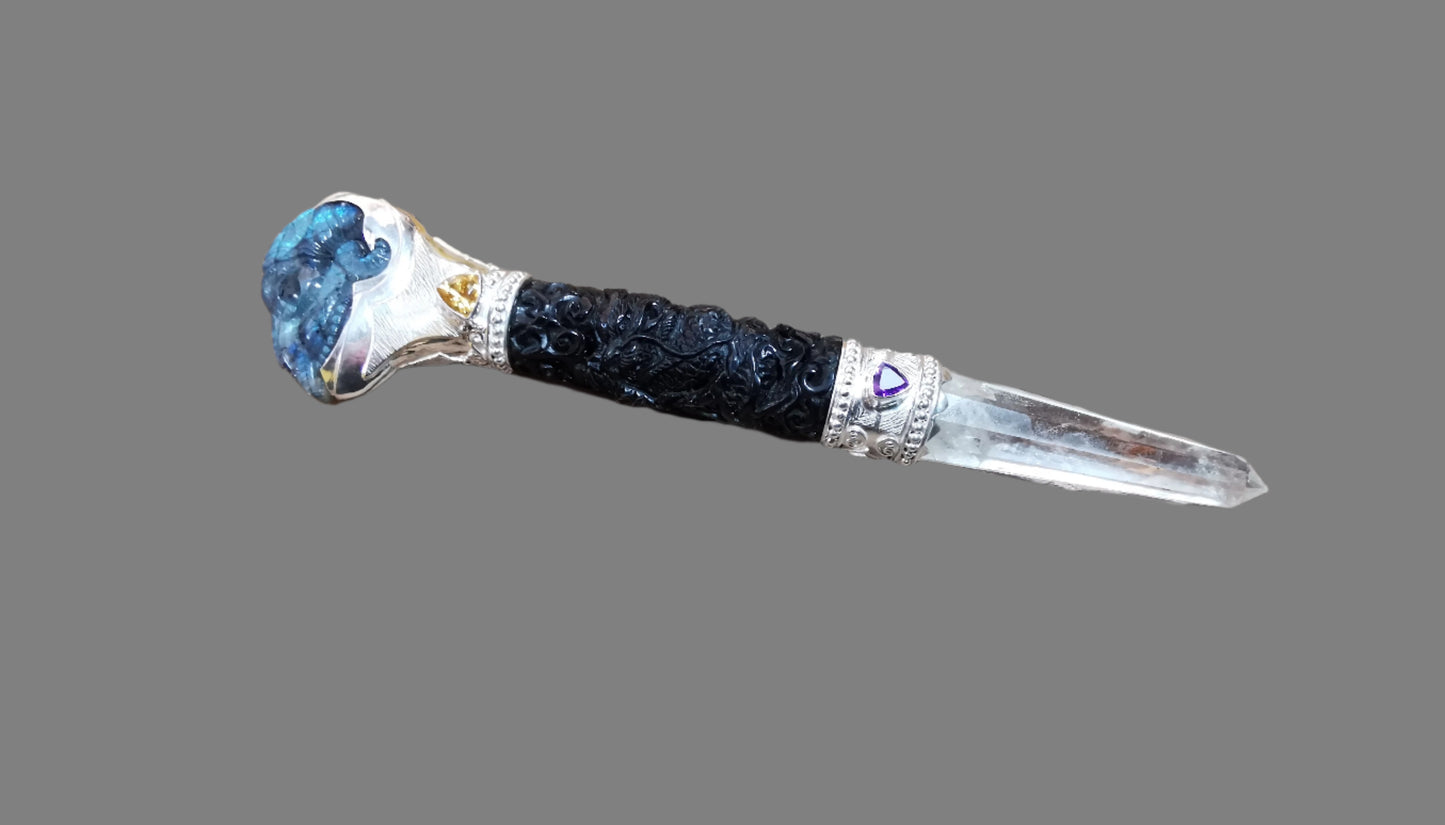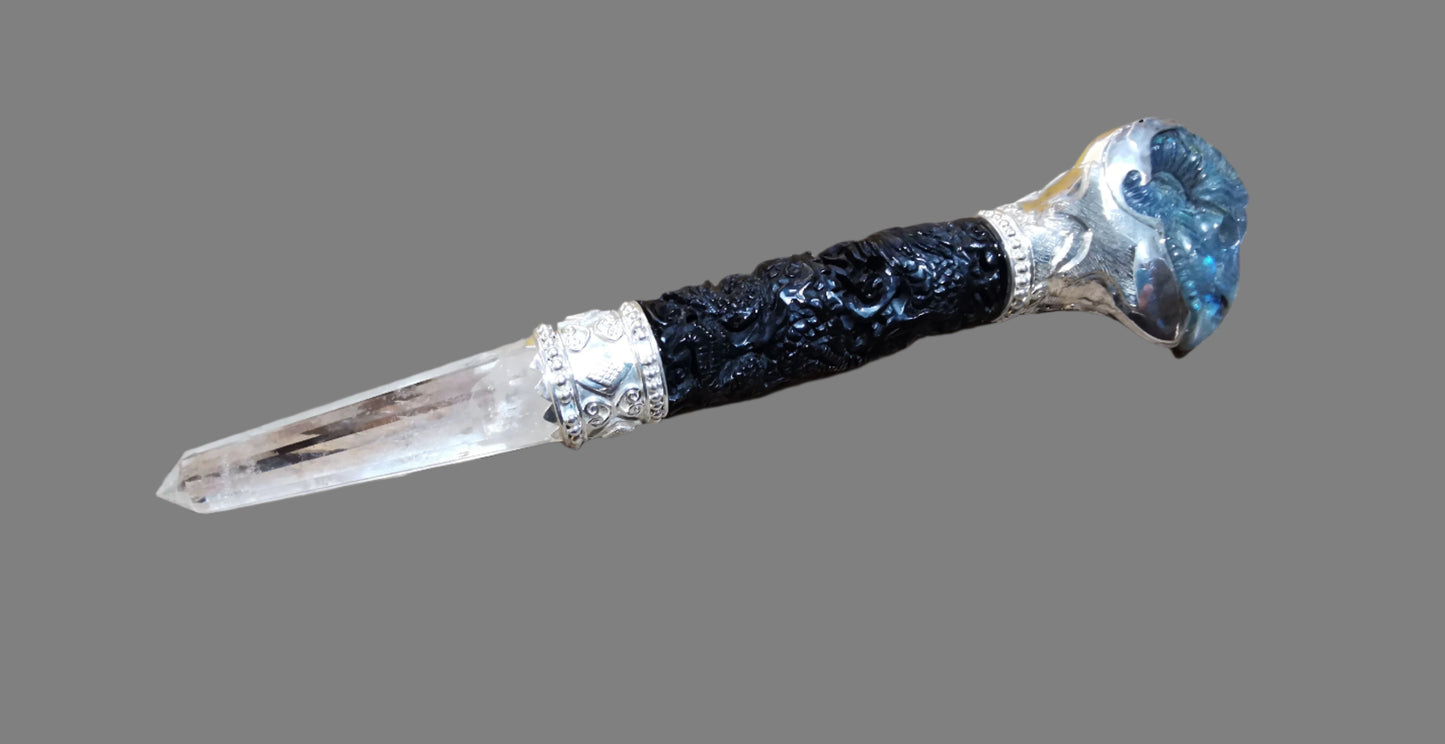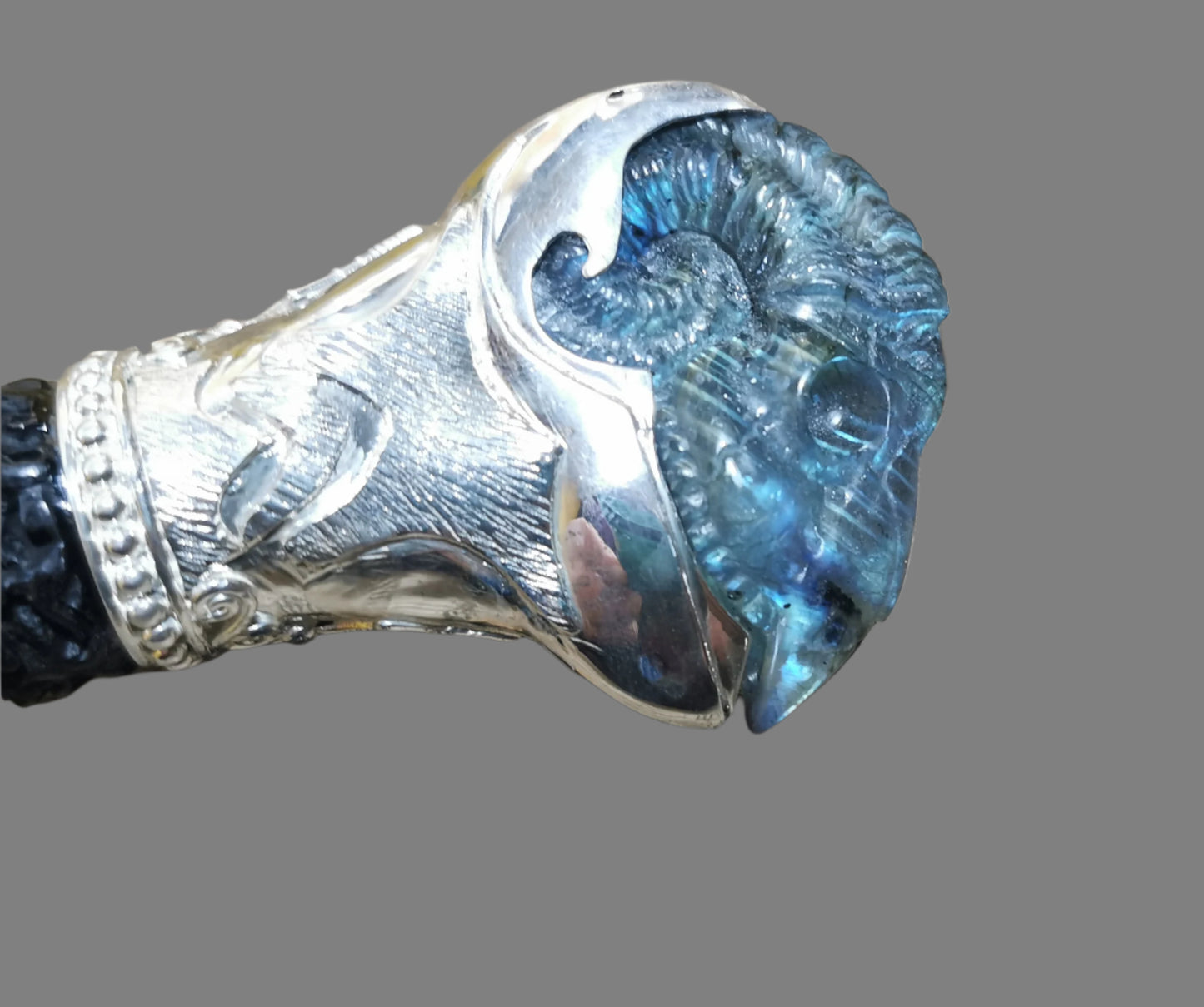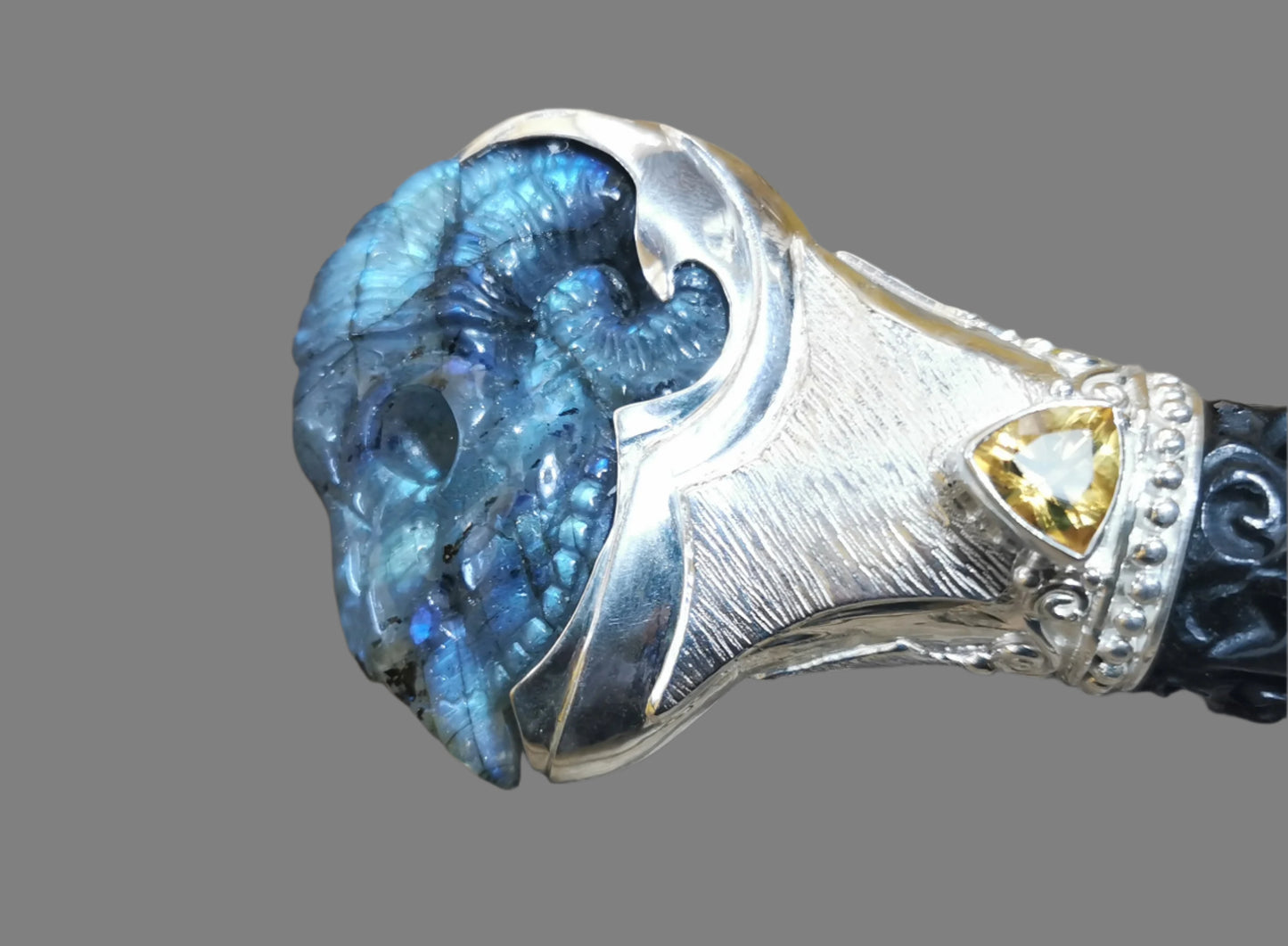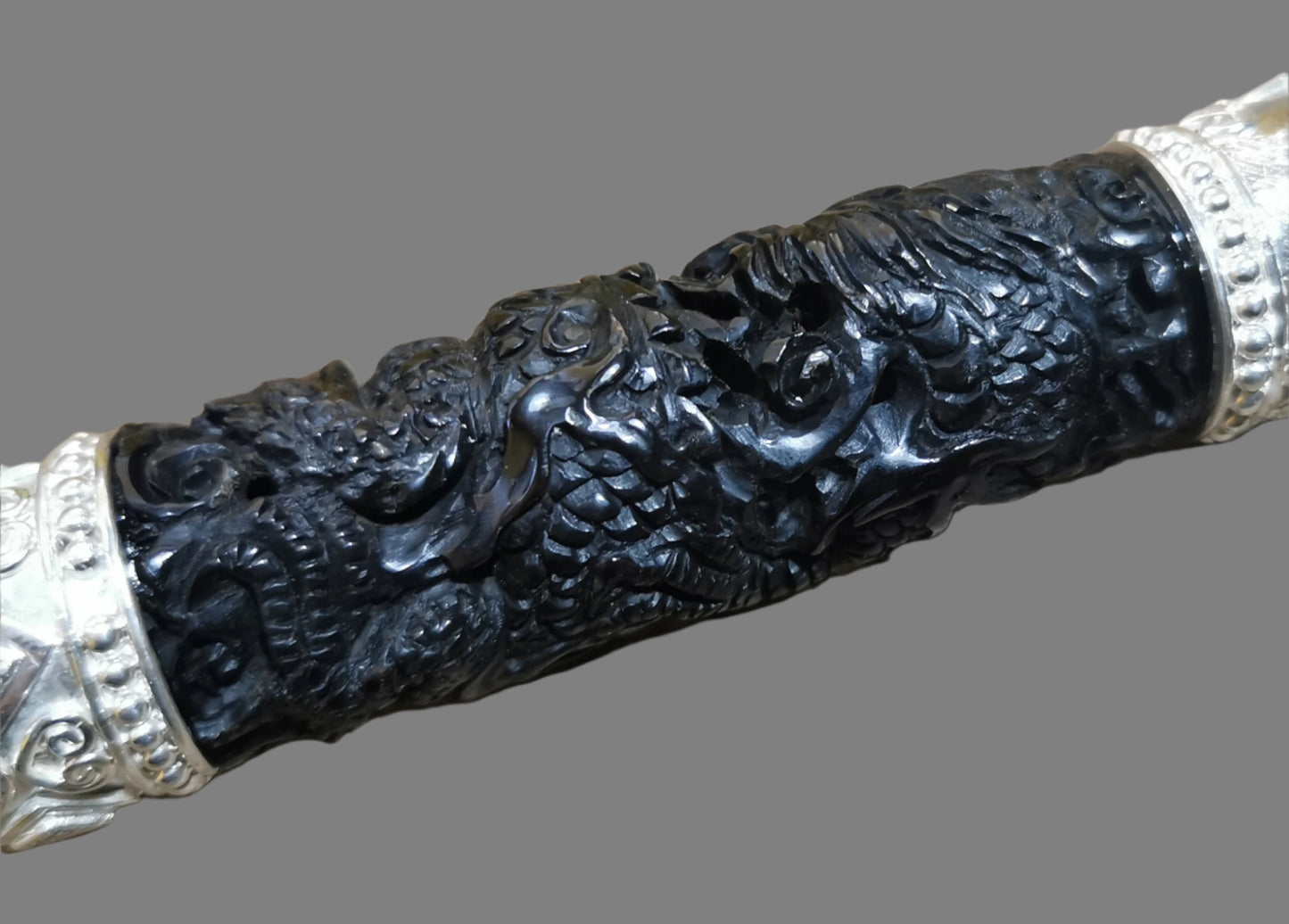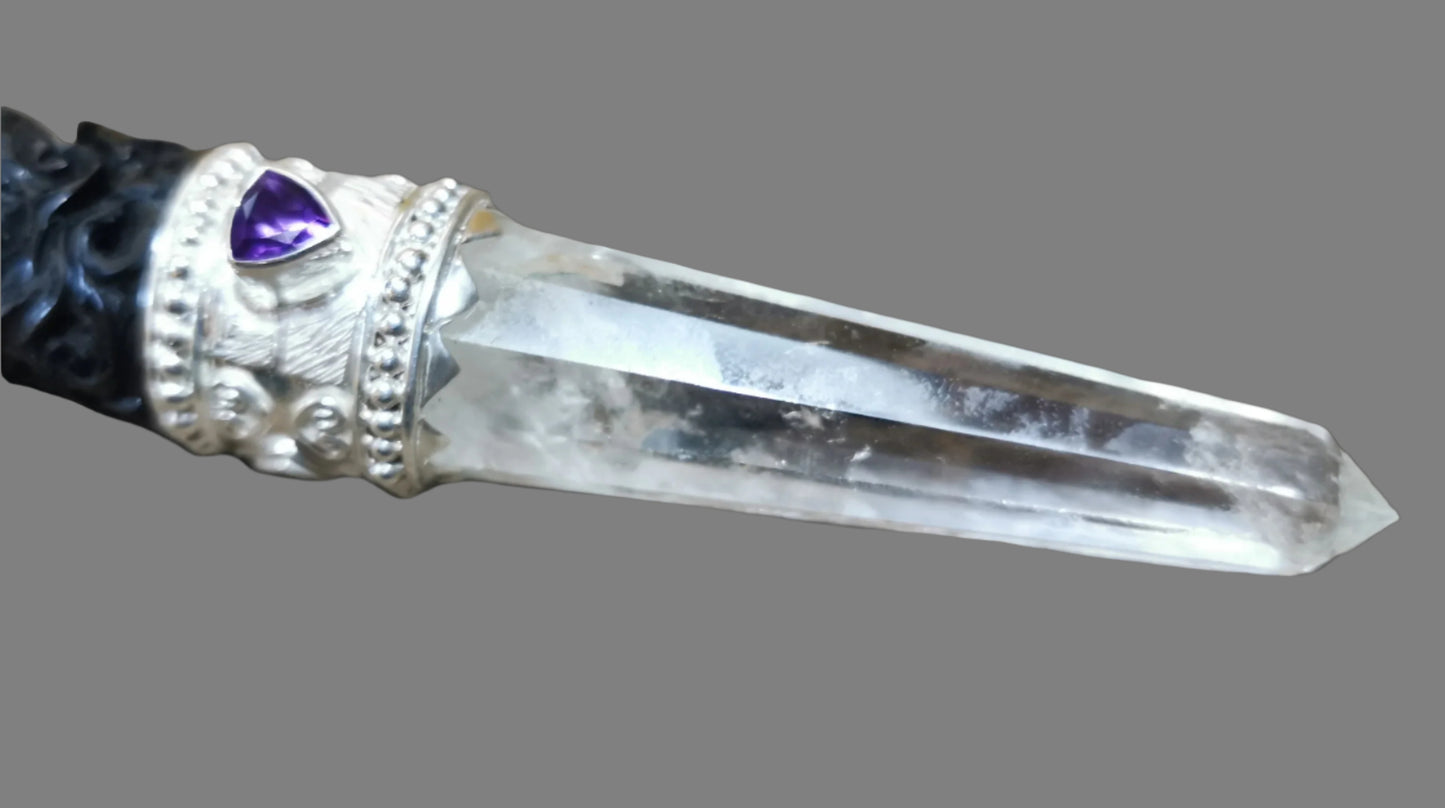Portal Glastonbury
Ref.WD0453
Ref.WD0453
Couldn't load pickup availability
Ref.WD0453 - Silver wand with iron wood carved handle with dragon motif, vogel quartz crystal, labradorite carved pommel with ram skull motif, citrine, and amethyst gemstones.
The symbolic significance of a Vogel crystal stems from its unique design, purpose, and the intentions behind its creation by Marcel Vogel, a scientist and spiritual researcher. These quartz crystals are meticulously cut to precise specifications, often embodying sacred geometry and metaphysical principles, which imbue them with layered symbolic meaning.
At its core, a Vogel crystal represents the harmonious intersection of science and spirituality. Marcel Vogel, who spent decades at IBM researching luminescence and material properties, later turned his focus to the metaphysical potential of quartz. His work resulted in crystals cut to amplify and direct Universal Life Force energy, making them symbols of the bridge between the tangible, physical world and the subtle, energetic realms of consciousness. This duality reflects a quest for understanding and balancing the material and the ethereal.
The specific cut of a Vogel crystal—often featuring a receptive (female) end with a wider angle and a transmitting (male) end with a narrower angle—symbolizes the flow of energy and intention. The receptive end draws in energy, while the transmitting end focuses and projects it, much like a lens or a laser. This design mirrors the process of taking in universal energy, refining it through intent, and directing it toward healing, transformation, or spiritual connection. Symbolically, it embodies the idea of channeling potential into purposeful action.
A key element of its symbolic significance lies in its alignment with the Kabbalistic Tree of Life, a mystical framework representing the structure of the universe and the human soul. Vogel drew inspiration from this pattern, believing that cutting quartz along its C-axis (the crystal’s natural line of symmetry) in a form reminiscent of the Tree of Life would enhance its resonance with life force energy. Thus, the Vogel crystal symbolizes a microcosm of cosmic order, reflecting the interconnectedness of all things and the potential for personal growth and enlightenment.
Additionally, the precise angles used in cutting—often 51 degrees, 51 minutes, and 51 seconds at the receptive end, matching the angle of the Great Pyramid of Giza—tie the crystal to ancient wisdom and sacred architecture. This connection suggests a link to timeless knowledge, stability, and the amplification of human potential, reinforcing its role as a tool for transformation and alignment with higher consciousness.
In practice, Vogel crystals are seen as conduits for healing, meditation, and intention-setting, symbolizing clarity, focus, and the power of the mind to shape reality. Vogel emphasized that these crystals must be cut with love and positive intent, infusing them with a symbolic essence of purity and compassion. They stand as emblems of the belief that human consciousness, when paired with the natural perfection of quartz, can transcend limitations and foster profound change.
In essence, the Vogel crystal symbolizes unity, precision, and the amplification of life’s inherent energy. It’s a testament to the idea that structure, intention, and spirit can converge to unlock deeper understanding and connection with the universe.
Ram medicine encompasses a variety of symbolic meanings and teachings that resonate across different cultures and spiritual practices:
Determination and Persistence: The ram is often seen as a symbol of unwavering determination and persistence. This animal's ability to scale heights and push through obstacles with its headstrong nature serves as a metaphor for overcoming life's challenges. Ram medicine encourages individuals to harness this energy to pursue goals relentlessly.
Leadership and Authority: Rams are naturally leaders within their flocks, symbolizing qualities of leadership, authority, and the ability to guide others. This aspect of ram medicine suggests taking initiative, being assertive, and leading by example, inspiring others through one's actions and decisions.
Strength and Power: The physical attributes of a ram, particularly its horns, symbolize strength, power, and the capacity for defense. In spiritual terms, this translates into inner strength, resilience, and the power to protect oneself and others from adversity.
Courage and Valor: The ram's fearless approach to life, often butting heads to assert dominance or protect its territory, illustrates courage and valor. This symbolism encourages individuals to face their fears, stand up for what they believe in, and tackle life's battles with bravery.
New Beginnings and Change: The ram heralds the arrival of new beginnings, urging one to embrace change and take the first step towards new ventures or personal transformation. This aspect of ram medicine teaches the importance of initiating action and welcoming new phases in life with optimism.
Sacrifice and Obedience: In a broader, non-divine context, the ram can symbolize the act of sacrifice for the greater good or the community, and obedience to one's inner moral compass or societal duties. It reflects the idea of giving up something of value for a higher purpose or the collective benefit.
Protection and Guardianship: With its defensive capabilities, the ram also symbolizes protection, guardianship, and the safeguarding of what one holds dear, whether it be family, ideals, or personal projects.
Fertility and Vitality: In many cultures, rams symbolize life force, vigor, and vitality due to their association with reproductive strength. This can translate to spiritual teachings about creativity, the generation of new ideas, or the renewal of one's spirit and energy.
Intellectual Growth: The ram's horns, often seen as a symbol of mental faculties, encourage intellectual stimulation, the pursuit of knowledge, and mental evolution. Ram medicine here might suggest to individuals to engage in activities that challenge the mind and promote growth.
Self-Reflection and Inner Work: The spiritual journey often involves looking inward. The ram can symbolize the need for introspection, understanding one's strengths and weaknesses, and working on self-improvement.
In summary, ram medicine, in its spiritual significance, teaches lessons of determination, leadership, strength, courage, embracing change, sacrifice, protection, vitality, intellectual growth, and self-reflection, all of which are valuable for personal development and navigating life's challenges.
Dragons symbology has evolved from traditional mythologies with additional layers that align with modern spirituality as:
- Transformation and Personal Growth: Dragons often symbolize profound transformation, akin to the shedding of skin seen in their serpentine relatives, focusing on personal evolution, spiritual awakening, and enlightenment.
- Wisdom and Knowledge: In many cultures, dragons are symbols of ancient wisdom and knowledge. In modern spirituality, this represents the pursuit of higher knowledge, esoteric wisdom, or the uncovering of hidden truths.
- Guardianship and Protection: Dragons are frequently protectors in mythology. In modern spirituality they might guard not just physical treasures but also spiritual or esoteric knowledge, offering protection to those on a spiritual quest.
- Power and Strength: The dragon's inherent power reflects personal empowerment, inner strength, and the ability to overcome challenges. This can inspire individuals to harness their own 'dragon energy' for overcoming obstacles.
- Elemental Mastery: Dragons are often linked to the elements (fire, water, air, earth), symbolizing mastery over natural forces, and likewise can relate to mastering one's own energies or chakra system.
- Kundalini Energy: In some interpretations, the dragon symbolizes the Kundalini energy, which lies dormant at the base of the spine and, when awakened, rises through the chakras, representing spiritual awakening and the unification of spirit and matter.
- Balance of Yin and Yang: Particularly in Eastern symbolism, dragons often represent the yang (masculine, active) aspect, which when paired with the yin (feminine, passive, often represented by the phoenix), symbolizes balance and harmony in life.
- Creativity and Manifestation: The dragon's breath, often fire, can symbolize creativity, the spark of life, and the power to manifest desires or to bring forth ideas into reality.
- Spiritual Guides: Dragons can act as spiritual guides or totems, leading individuals through life's journeys, providing insights, or warning of dangers.
- The Shadow Self: In psychological terms, dragons might symbolize the 'shadow' self or the parts of ourselves we fear or suppress, encouraging exploration and integration of these aspects for wholeness.
- Immortality and Eternity: Due to their association with ancient lore and their mythical longevity, dragons can symbolize immortality, the eternal soul, or the cyclical nature of life.
- Alchemy: Dragons in alchemy represent the prime matter, the chaos, or the unrefined potential that the alchemist seeks to transform into something purified or enlightened.
- Cultural Fusion: The dragon's symbolism has been adopted and adapted globally, making it a universal symbol in modern spiritual thought, representing unity and the blending of different spiritual paths.
- Healing: Some practitioners see dragons as having healing energies, especially in the context of energy healing or crystal therapy, where dragons might be invoked for their protective or transformative powers.
Dragons are not just creatures of lore but are symbols imbued with deep spiritual significance, encouraging personal growth, spiritual exploration, and the integration of ancient wisdom with modern spiritual practices.
Size: 217mm/8.54in approx.
